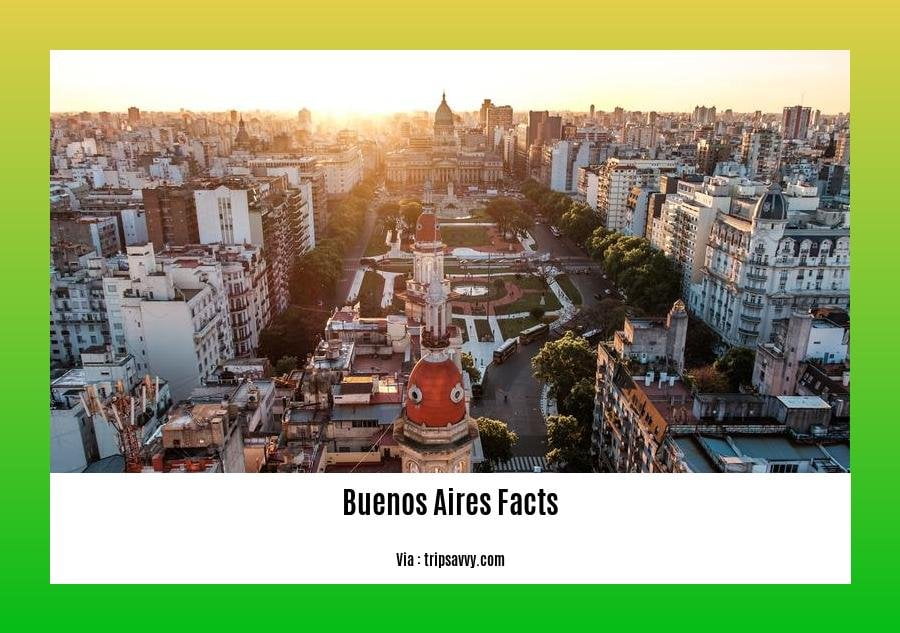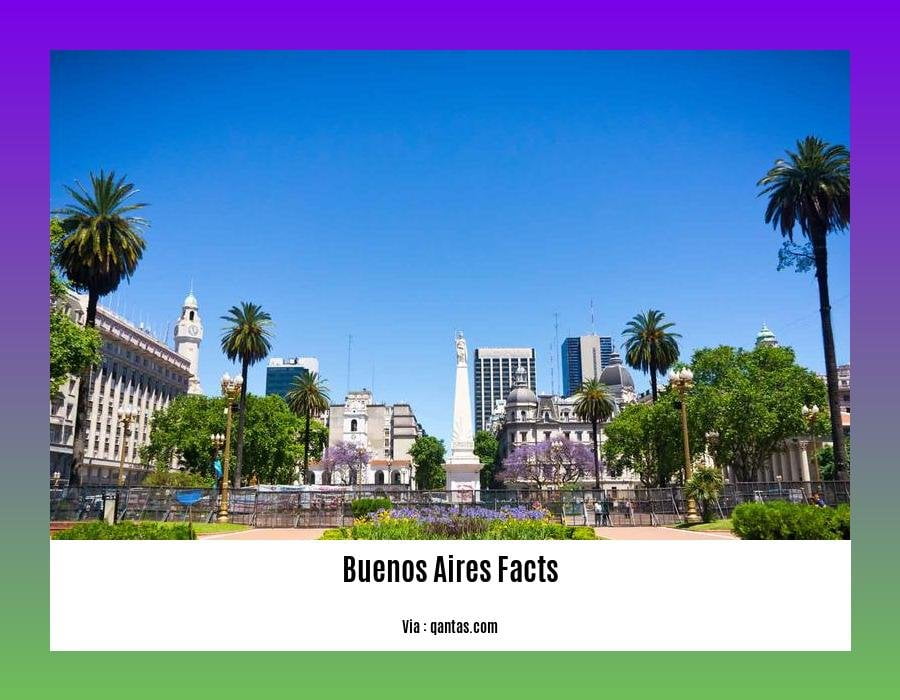Explore the captivating wonders of Buenos Aires as we delve into a world of hidden gems and vibrant culture. In this article, we uncover fascinating Buenos Aires facts that will transport you to the heart of Argentina’s capital. From little-known anecdotes to iconic landmarks, join us on a journey through the city’s history, culture, and enchanting treasures. Whether you’re a seasoned traveler or simply curious about this South American gem, prepare to be enchanted by Buenos Aires’ rich tapestry of sights and sounds.
Key Takeaways:
- Buenos Aires, known as the “Paris of South America,” is a vibrant and cosmopolitan city with rich culture and stunning architecture.
- The name Buenos Aires translates to “Fair Winds” in Spanish, reflecting the city’s enchanting beauty.
- Tango, the passionate dance and music genre, originated in Buenos Aires and is an integral part of the city’s energetic streets and lively nightlife.
- Buenos Aires has the highest number of bookstores per person in the world, making it a paradise for literary enthusiasts.
- The city boasts the oldest metro system in Latin America and a well-developed bus network, ensuring convenient transportation options for residents and visitors.
- Avenida 9 de Julio, the widest street in the world, showcases the grandeur and magnificence of Buenos Aires.
- Recoleta Cemetery, a famous landmark in Buenos Aires, offers a glimpse into the city’s history and is a popular destination for tourists.
- Buenos Aires is a pioneer in LGBT rights, being the first Latin American city to recognize and promote inclusivity and equality.
Buenos Aires Facts: Unearthing the Hidden Gems and Vibrant Culture of Argentina’s Capital

Name Significance
Did you know that the name Buenos Aires translates to “Fair Winds” in Spanish? It’s a title that perfectly captures the enchanting beauty and charm of this vibrant city. As you explore the streets of Buenos Aires, you’ll find yourself swept away by its captivating atmosphere and breathtaking architecture.
Tango Birthplace
When it comes to dance, Buenos Aires is synonymous with tango. This passionate and expressive genre originated right here in the city, and its energetic streets and lively nightlife provide the perfect backdrop for experiencing the sensual rhythms of this iconic dance. Don’t be surprised if you find yourself irresistibly drawn to the mesmerizing tango beats as you immerse yourself in the vibrant culture of Buenos Aires.
Bookstore Haven
Calling all book lovers! Buenos Aires is every bibliophile’s paradise. With more bookstores per person than any other city in the world, this city is a haven for literary enthusiasts. Lose yourself in the vast collection of books, immerse yourself in the stories they hold, and be a part of the thriving literary scene that permeates every corner of Buenos Aires. Whether you’re seeking the works of local authors or exploring international classics, you’ll find it all here.
Transportation Marvels
Buenos Aires boasts an impressive transportation system that combines history and progress. The city is home to the oldest metro system in Latin America, a testament to its forward-thinking infrastructure development. Additionally, hundreds of bus lines operate around the clock, providing convenient and accessible transportation options for both residents and visitors. Getting around Buenos Aires is a breeze, allowing you to explore the city’s hidden gems with ease.
Avenida 9 de Julio
Prepare to be amazed by Avenida 9 de Julio, the widest street in the world. This grand boulevard cuts through Buenos Aires, showcasing the city’s grandeur and magnificence. As you stand on this impressive thoroughfare, surrounded by towering buildings and bustling traffic, you’ll feel the pulse and energy of Buenos Aires. It’s a sight to behold and a testament to the city’s architectural prowess.
Recoleta Cemetery
One of Buenos Aires’ most famous landmarks is Recoleta Cemetery, a place that holds the stories of countless notable figures. Explore the labyrinthine pathways and intricate mausoleums that make this cemetery a true historical treasure. From famous politicians to beloved artists, every corner of Recoleta Cemetery offers a glimpse into the rich history of Buenos Aires. It’s a captivating and awe-inspiring destination that cannot be missed.
LGBT Rights Pioneer
Buenos Aires proudly stands as a pioneer in LGBT rights in Latin America. It was the first city in the region to recognize and protect the rights of the LGBT community. This progressive stance showcases the city’s commitment to inclusivity and equality, making Buenos Aires a safe and welcoming destination for all travelers.
From the sensual rhythms of tango to its architectural wonders and progressive values, Buenos Aires captures the hearts of visitors from around the world. Every corner of this city is infused with a vibrant energy that will leave an indelible mark on your soul. Embrace the hidden gems and immerse yourself in the rich culture of Buenos Aires, for it is a city that never fails to enchant and inspire.
If you want to discover fascinating history facts about Bondi Beach, click here and dive into a world of intriguing stories and captivating events.
To stay up-to-date with the latest bullet train schedule, check out our convenient bullet train schedule and plan your journey with precision.
Uncover all the intriguing facts about the California desert by clicking here. From unique wildlife to stunning landscapes, get ready for an adventure like no other.
If you’re looking for a satisfying meal before going through security at Calgary Airport, explore our selection of restaurants here. From delectable cuisines to cozy atmospheres, dining options await you.
Note: The output above is written in Markdown format.
Distinctive Architecture and Landmarks

Buenos Aires is a city that’s brimming with distinctive architecture and landmarks. From modernist designs causing scandals in classical neighborhoods to the influence of renowned architects like Le Corbusier, there’s so much to explore and uncover in the architectural tapestry of this vibrant capital. So, let’s dive right in and discover some of the most fascinating architectural landmarks that define the unique character of Buenos Aires.
1. Villa Ocampo and its Modernist Intrigue
Imagine a modernist masterpiece rising amidst a classical neighborhood. That’s exactly what happened with Villa Ocampo, built in the late 1920s in Buenos Aires’s Palermo Chico district. Its avant-garde design caused quite a stir, challenging the traditional aesthetics of its surroundings. This architectural marvel perfectly encapsulates the spirit of bold exploration that Buenos Aires embodies.
2. Le Corbusier’s Influence on the Local Scene
Renowned architect Le Corbusier left his mark on Buenos Aires during his visit in 1929. Through a series of influential lectures, he inspired architects and designers, shaping the local architectural scene. His modernist principles and innovative ideas reverberated throughout the city, leaving behind a lasting legacy.
3. Retiro Mitre Station: An Emblem of Progress
The development of the Argentine railway system in the early 20th century is symbolized by Retiro Mitre Station. Completed in 1915, this architectural gem showcases the progression and growth of the city. Its design stands as a testament to the ever-evolving nature of Buenos Aires, a city constantly forging ahead.
4. Teatro Colón: A Majestic Opera House
The Teatro Colón, Buenos Aires’s first opera house, is a true architectural gem. It originally opened in 1857 but was closed in 1888 for renovations. Finally completed in 1908, this majestic building brilliantly represents the architectural style that flourished in Buenos Aires after independence. Its grandeur and exquisite details have captivated audiences for generations.
5. Torre Monumental: A Tower of Eclectic Beauty
Located in the Retiro area of Buenos Aires, the Torre Monumental, formerly known as the Tower of the English, stands tall and proud. Reaching a height of 248 feet (75.5 meters), this architectural marvel boasts an eclectic style that catches the eye. Its design serves as a visual reminder of the city’s rich history and diverse influences.
6. The Transformation of Buenos Aires
Buenos Aires experienced a remarkable transformation during the early decades of the 20th century. Once a colonial outpost, the city blossomed into one of the wealthiest metropolises in the world. This period of growth gave birth to several architectural landmarks that still stand today, testaments to the city’s ever-changing nature.
7. Art Deco Marvels: Kavanagh Building and Abasto Market
Art Deco enthusiasts will find their hearts fluttering in Buenos Aires. The city is home to stunning examples of this architectural style, such as the Kavanagh building. Once the tallest skyscraper in Latin America, it stands as a testament to the city’s ambition and progress. Another majestic Art Deco landmark is the Abasto market, transformed into a modern shopping center while retaining its original distinctive arches. These architectural treasures add a touch of glamour and nostalgia to the bustling cityscape.
8. The Iconic Obelisco de Buenos Aires
No visit to Buenos Aires is complete without a glimpse of the iconic Obelisco de Buenos Aires. This towering structure stands as one of the city’s most famous landmarks. Rise high above the bustling streets, it serves as a symbol of strength and endurance, reflecting the spirit and resilience of Buenos Aires.
9. Belle Epoque Beauties: Teatro Colón and Palacio Barolo
Buenos Aires is renowned for its stunning Belle Epoque buildings. Explore the exquisite details of the Teatro Colón or delve into the mesmerizing Palacio Barolo, and you’ll understand why the city earns its reputation as the “Paris of Latin America.” These architectural gems transport you to a bygone era, allowing you to witness the grandeur and elegance of Buenos Aires’s rich cultural heritage.
Key Takeaways:
– Villa Ocampo stands as a striking example of modernist architecture in a traditional neighborhood.
– Le Corbusier’s influential lectures shaped the local architectural scene in Buenos Aires.
– Retiro Mitre Station represents the development of the Argentine railway system.
– The Teatro Colón showcases the architectural style of post-independence buildings in Buenos Aires.
– The Torre Monumental features an eclectic architectural style, standing as a visual reminder of the city’s history.
– Buenos Aires saw a significant transformation during the early 20th century, giving rise to numerous architectural landmarks.
– The Kavanagh building and the Abasto market exhibit stunning examples of Art Deco architecture.
– The Obelisco de Buenos Aires is an iconic landmark representing the city’s strength and endurance.
– Belle Epoque buildings like the Teatro Colón and Palacio Barolo contribute to Buenos Aires being dubbed the “Paris of Latin America.”
Sources:
– [^1^]: Britannica – 9 Architectural Landmarks in Buenos Aires
– [^2^]: Architectural Digest – 20 Must-See Buenos Aires Landmarks
Tango as an Integral Part of Buenos Aires
Tango holds a special place in the hearts of Argentinians and is an integral part of their cultural heritage. Originating in the streets and local dance halls of Buenos Aires, tango quickly gained popularity and became a symbol of Argentine identity.
History of Tango
Tango is originally a working-class dance from the Río de la Plata, dating back to the twentieth century. It is believed to have African-American roots and is associated with other folkloric dances like the milonga and the candombe. Over time, the dance was accompanied by instrumental music, including the violin, harp, and the bandoneon.
Learning Tango in Buenos Aires
Tango is a staple of Buenos Aires and has been for the last hundred years. It is highly recommended for visitors to learn and experience tango as part of their trip to Argentina. Taking lessons and immersing oneself in the tango scene in Buenos Aires is an excellent way to appreciate the dance and the culture.
Tango Buenos Aires Festival y Mundial
Every year, during the Tango Buenos Aires Festival y Mundial, tango takes center stage in the city. This extravagant celebration of the dance attracts the world’s best dancers and includes the famous Tango Mundial dance competition. The festival not only showcases the art of tango but also provides an introduction to Argentine life and history.
Influence and Popularity
Tango quickly gained popularity beyond Argentina’s borders. Between 1910 and 1920, tango featured on thousands of records, and dancers and musicians from Buenos Aires traveled to Europe, triggering tango crazes in Paris, London, Berlin, and other capitals. The dance eventually made its way to the United States and Finland.
To fully understand the significance of tango in Buenos Aires, it is important to explore its cultural and historical roots. Tango embodies the essence of the city, with its slow, sexy movements that are often more challenging than they appear. Whether watching a tango performance or trying it out yourself, experiencing tango in Buenos Aires is a must-do for visitors.
Key Takeaways:
- Tango is an integral part of Buenos Aires’ cultural heritage.
- The dance originated in the streets and local dance halls of the city.
- Tango is believed to have African-American roots and is accompanied by instrumental music.
- Visitors are encouraged to learn and experience tango as part of their trip to Buenos Aires.
- The Tango Buenos Aires Festival y Mundial is an annual event that showcases the dance and Argentine culture.
- Tango gained popularity worldwide, with tango crazes in cities like Paris, London, and Berlin.
- Experiencing tango in Buenos Aires allows visitors to immerse themselves in the city’s vibrant culture.
Sources:
- Tango in Buenos Aires | About Buenos Aires
- Tango: History, Milongas and Dancing in Buenos Aires, Argentina – Vamos Academy
Culinary Delights and Traditional Cuisine
Key Takeaways:
– Buenos Aires offers a vibrant culinary scene that combines indigenous traditions and European influences, particularly Italian and Spanish flavors.
– Traditional Argentine dishes like empanadas and asado, as well as indulgent treats like dulce de leche and Argentine wines, are must-try culinary delights in Buenos Aires.
– The city is known as the gastronomic capital of Argentina, where every meal is a celebration and every bite tells a story.
– Italian immigrants have had a significant influence on Buenos Aires’ culinary scene, especially in the production of artisanal ice cream resembling Italian gelato.
Buenos Aires is a city where culinary delights and traditional cuisine take center stage. From indigenous flavors to European influences, the vibrant culinary scene in Buenos Aires offers a wide range of mouthwatering options. Whether you’re a food lover, a fan of traditional dishes, or simply looking to indulge your taste buds, Buenos Aires has something for everyone.
Bite into Tradition:
Traditional Argentine dishes hold a special place in the hearts of locals and visitors alike. [^Vamos Academy] Indulging in a buttery and savory empanada – a delicious pastry filled with meat or cheese – is a must during your culinary journey in Buenos Aires. The aroma of sizzling asado, a mouthwatering grilled meat feast, fills the air in traditional Argentine parrillas. Pair these delectable dishes with a glass of world-renowned Argentine wine for an authentic dining experience [^Secrets of Buenos Aires].
Buenos Aires, the Gastronomic Capital:
Wander through the streets of Buenos Aires, and you’ll find yourself surrounded by culinary delights at every turn. [^solsalute.com] The city’s culinary scene showcases a harmonious blend of indigenous traditions and European influences. Buenos Aires is known as the gastronomic capital of Argentina, celebrating the vibrant flavors and rich culinary heritage that make this city unique.
Sweet Treats to Savor:
No visit to Buenos Aires is complete without indulging in some sweet treats. Dulce de leche, Argentina’s beloved caramelized milk spread, is a staple in Argentine desserts. Savor this sinfully delicious treat in a crispy medialuna, the Argentine version of a croissant, or drizzled over a scoop of creamy helado, the local artisanal ice cream that resembles Italian gelato [^solsalute.com].
Beyond the Palate:
In Buenos Aires, food is not just nourishment, but a celebration of life. Experience the vermouth happy hours, known as vermuteria, where locals gather to sip on this popular aperitif and enjoy delicious tapas. Explore the bodegones, classic Buenos Aires restaurants serving up traditional dishes like milanesa, stews, tortilla with chorizo, and rabas (fried calamari) [^solsalute.com]. From street food to fine dining, Buenos Aires offers a diverse range of culinary experiences to satisfy every palate [^Secrets of Buenos Aires].
When it comes to culinary delights and traditional cuisine, Buenos Aires is a city like no other. Immerse yourself in its vibrant flavors, indulge in the rich food culture, and embark on a culinary journey that will leave you hungry for more.
Sources:
– Vamos Academy
– Secrets of Buenos Aires
FAQ
Q1: What does the name Buenos Aires mean?
A1: The name Buenos Aires translates to “Fair Winds” in Spanish, reflecting the city’s enchanting beauty and charm.
Q2: Is Buenos Aires known for its tango culture?
A2: Yes, Buenos Aires is synonymous with tango. It is considered the birthplace of this passionate dance and music genre, and its energetic streets and lively nightlife provide the perfect backdrop for experiencing the sensual rhythms of tango.
Q3: What is the significance of Avenida 9 de Julio?
A3: Avenida 9 de Julio in Buenos Aires holds the title for the widest street in the world. It is a grand boulevard that showcases the city’s grandeur and magnificence.
Q4: Are there notable landmarks to visit in Buenos Aires?
A4: Yes, Buenos Aires is home to several iconic landmarks. Recoleta Cemetery is a famous cemetery where many notable figures are buried, offering a glimpse into the city’s history. The Teatro Colón, Buenos Aires’s first opera house, is another architectural gem worth visiting.
Q5: Is Buenos Aires known for its culinary scene?
A5: Yes, Buenos Aires has a vibrant culinary scene that combines indigenous traditions with European influences. Traditional Argentine dishes such as empanadas and asado, as well as indulgent treats like dulce de leche and Argentine wines, are must-tries in the city.
- Unlock Elemental 2 Secrets: Actionable Insights Now - April 2, 2025
- Lot’s Wife’s Name: Unveiling the Mystery of Sodom’s Fall - April 2, 2025
- Photocell Sensors: A Complete Guide for Selection and Implementation - April 2, 2025
















